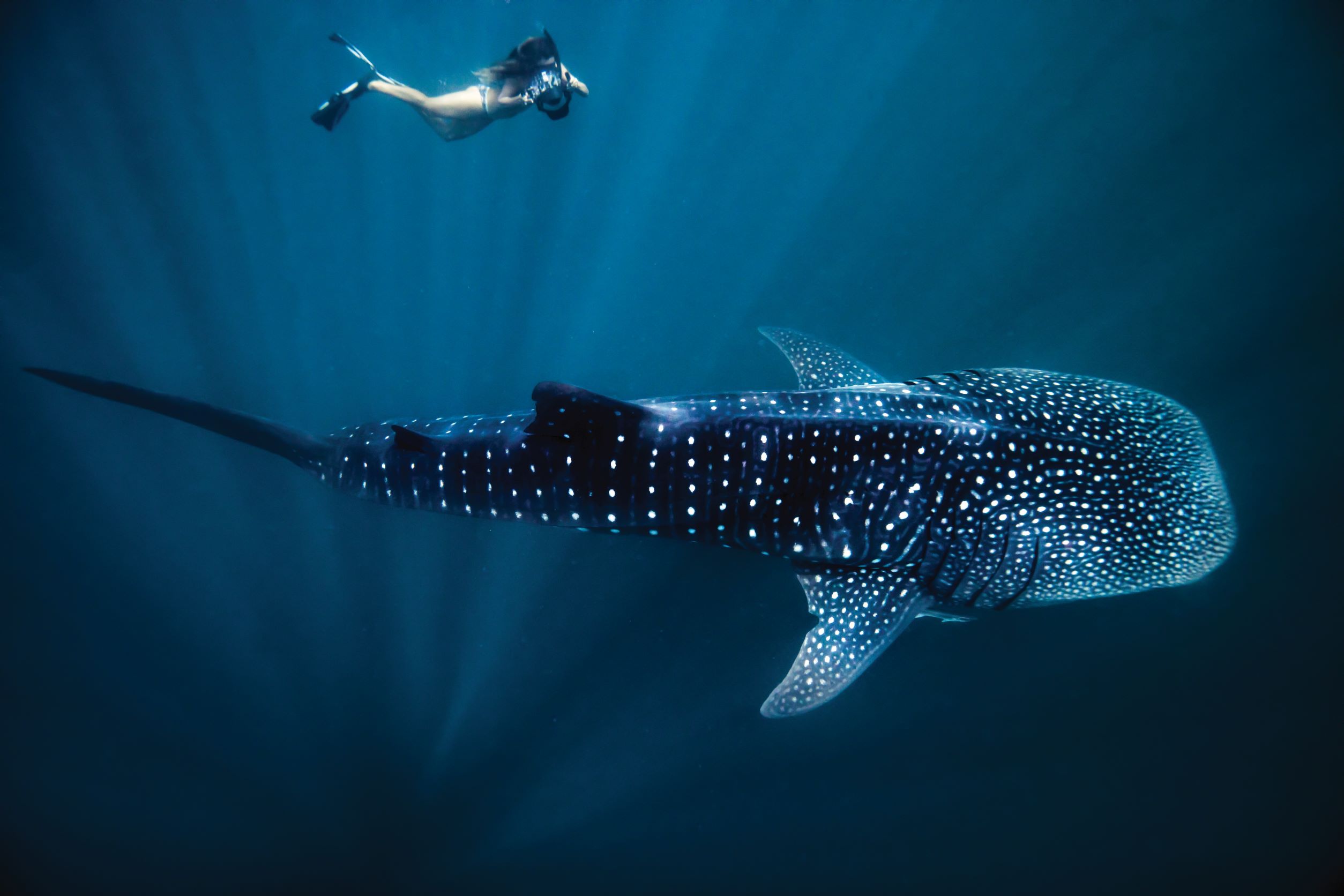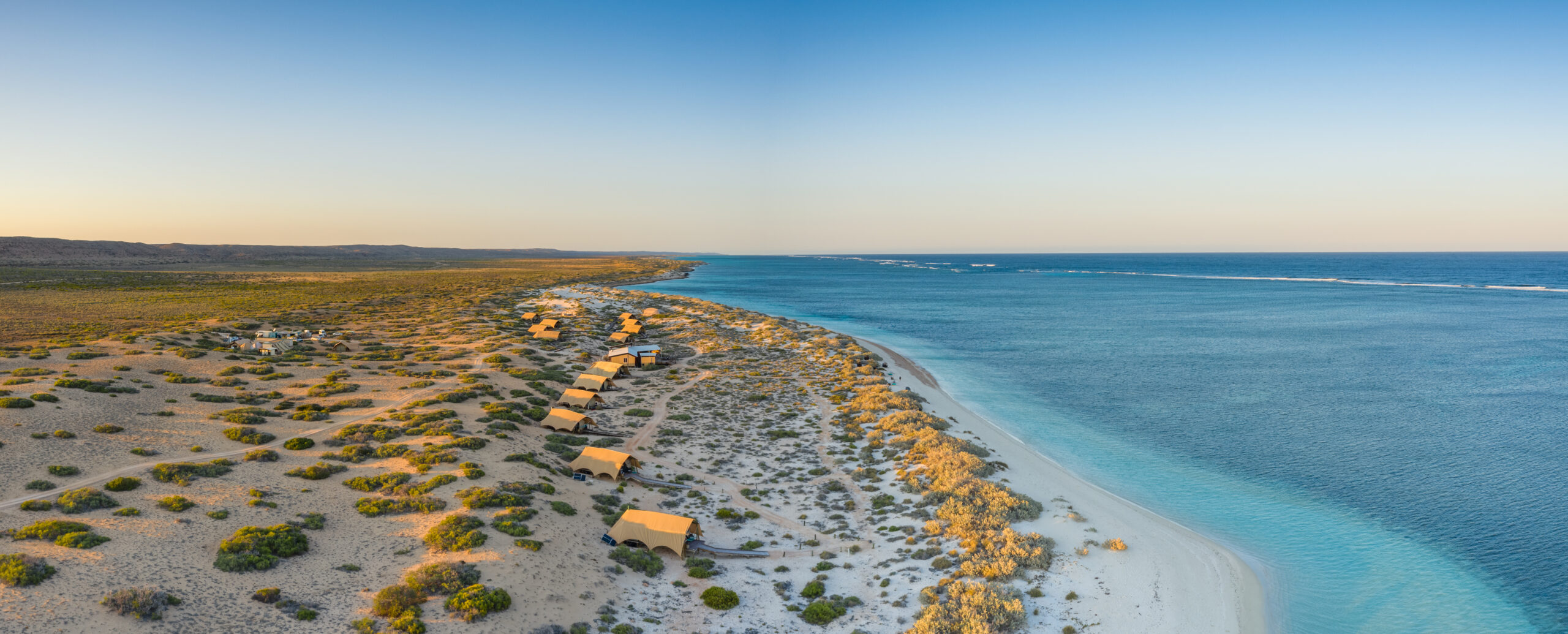

Gazing into the eye of a whale shark is a quintessential Ningaloo experience. But there’s more than one way to explore Australia’s other great coral reef. The World Heritage-listed Ningaloo Reef is home to the largest fringing reef on earth and invites up-close encounters with myriad marine creatures. Humpback whales, manta rays, dugongs, orcas, sharks, turtles, and dolphins all thrive here, together with 500 species of fish and more than 200 varieties of coral. Ningaloo Reef, extending 300km along the mid-north coast of Western Australia, is a wish-list delight. For a destination celebrated for its natural wonders, Ningaloo’s pledge to the planet is especially personal. This is a place to tread lightly and connect deeply. A place where sustainable tourism is lived, not hyperbolised, and visitors can make a positive impact.
SUSTAINABLE STAY
If the idea of sustainable eco-stays conjures visions of windblown tents and grungy sleeping bags, prepare to be awestruck at Sal Salis Ningaloo Reef. Tucked into the dunes between the dramatic curves of Cape Range National Park and the infinite expanse of the Indian Ocean, this luxe private hideaway walks the eco talk. The 16 safari retreats are ‘tents’ in name only. Think king-size jarrah hardwood beds, organic cotton linen, private ensuites, and timber decks with hammocks designed for drinking in those uninterrupted sea views. However, it’s the things you can’t see that make a difference: the solar panels powering the property, the raised foundations protecting delicate dunes, the cool coastal breeze harnessed in lieu of air conditioning, and a portion of the turnover is invested in local conservation initiatives.
Sal Salis is a wilderness stay where comfort comes with an environmental conscience. It’s a place where you can wake to kangaroos gnawing on the grass and fall asleep to the sound of lapping waves. In between, there are coral reefs, secluded beaches and limestone gorges to explore.
WONDROUS WILDLIFE
Thousands flock to Ningaloo every year to swim with the biggest fish in the sea, and these open-water encounters are carefully managed to protect the whale sharks. Every year between March and August, up to 500 whale sharks migrate to Ningaloo in one of the largest aggregations in the world, coinciding with a mass coral spawning event. Numerous cruise operators offer the once in-a-lifetime opportunity to swim with these bejewelled queens of the sea, using spotter planes to determine their whereabouts. Trips depart from Exmouth, near the tip of the North West Cape, and from the tourist town of Coral Bay, a little further south. When the skipper gets word of a whale shark sighting, the anticipation on deck is electric as neoprene clad snorkellers prepare to jump overboard. “Go, go, go!” comes the command, and swimmers slip quickly and quietly into the sea.

“Ningaloo (Nyinggulu), meaning ‘land jutting out to sea’, is the traditional land of the Baiyungu, Thalanyji and Yinggarda (Yingkarta) Peoples.”
There are no more than 10 people in the water at a time and only one vessel is permitted within a 250m exclusion zone. Swimmers also have an obligation – enforced by the crew – to do right by the whales. Flash photography is prohibited, selfie sticks are out, and swimmers cannot get within three metres of the whale shark.
Similar protocols apply when viewing humpbacks. An estimated 30,000 humpbacks pass through Ningaloo between July and October each year, making a beeline for the Exmouth Gulf, a breeding and calving ground boasting the highest concentration of humpbacks in the southern hemisphere and the best time to travel for this experience. To see them, you can join a whale-watching cruise or even participate in an in-water interaction. In 2016, the Western Australia Parks and Wildlife Service started a whale swimming trial, enabling guided snorkellers to get within 100m of the mammals for the first time.

A licensing program is due to start in 2024. But it’s not just the giants of the sea you can swim with at Ningaloo. Turtle and manta ray encounters are also popular, and both are ethically managed.
“Sal Salis is a wilderness stay where comfort comes with an environmental conscience. A place where you can wake to kangaroos gnawing on the grass and fall asleep to the sound of lapping waves.”
CITIZEN SCIENCE
For a more immersive turtle experience that contributes to the long-term sustainability of the cape’s green, loggerhead and hawksbill species, become a volunteer ‘Turtle Tracker’ with the Ningaloo Turtle Program. The five-week program involves monitoring remote beaches on the North West Cape, recording nesting data and assisting with turtle rescues. To view turtles without getting your hands dirty, head to the Jurabi Turtle Centre near Exmouth, where you can join a guide on an eco-education tour to observe turtles nesting and hatching in the wild without disturbing this vital part of their lifecycle.
Away from the water, there are other ways visitors to Ningaloo can leave a lasting impact on the natural environment. Cape Conservation Group runs a community monitoring program of endangered black-flanked rock wallabies in Cape Range National Park: tourists can help by reporting sightings of the marsupials.
CONSERVING CULTURE
What better way to learn about conservation than from First Nations People who have been living in harmony with the natural environment on the Ningaloo Coast for more than 30,000 years. Ningaloo (Nyinggulu), meaning ‘land jutting out to sea’, is the traditional land of the Baiyungu, Thalanyji and Yinggarda (Yingkarta) Peoples. On a ‘tagalong’ tour with Baiyungu woman Hazel Walgar, you can explore the coastal plain near Coral Bay through an Indigenous lens. Hear Dreamtime creation stories, see shell middens harking back to early years of Aboriginal occupation, swim at secluded beaches, visit a sea turtle nursery and learn how to find fresh water in the otherwise parched dunes.
At sundown, head to Cardabia Station, a 173,000ha working station owned by the Baiyungu Aboriginal Corporation. Learn about the property’s history and enjoy sunset yarns around the campfire. Personalised tours into the limestone gorges and spinifex-dotted canyons of Cape Range National Park can also be arranged. You will need a four-wheel drive (available for hire in Exmouth). Now you’re really in the outback and connected to Country.

With availability in July and August, you can explore the beauty of Ningaloo Reef at Sal Salis. Whale shark and humpback swims have limited availability, so book early to secure your place. Discover more here.
